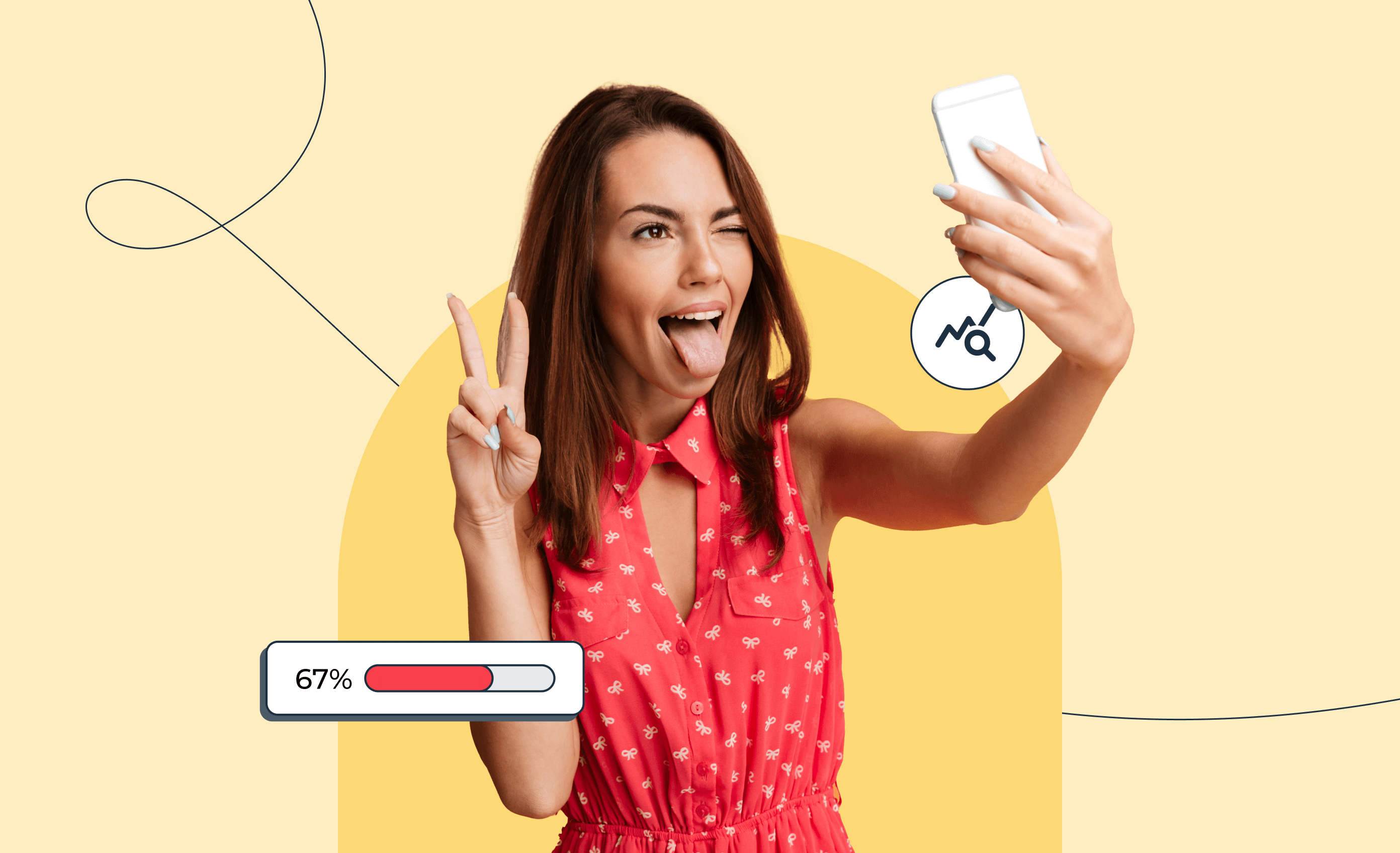In 2002, Nathan Hope unintentionally coined “selfie” after posting a blurry self-portrait online.
This act mirrored a deep-rooted human need to explore identity, a theme resonating throughout history, from aristocratic portraits to today’s digital self-representations.
So—
At PhotoAiD, we’ve decided to survey 1,000+ Americans and unravel the nation’s selfie-taking habits, including frequency, motives, and attitudes.
Curious about what we found?
Read on.
Key Takeaways
- Over half of Americans (60%) take selfies at least once a week.
- People usually take selfies at various times throughout the day (36%), with mornings (20%) and evenings (18%) being other popular options.
- The top spots for taking selfies are outdoors (21%), at home (18.89%) and while traveling (18.65%).
- On average, 59% of respondents spend up to two minutes taking a selfie.
- The most common selfie edit is cropping, rotating, or flipping (16%).
- Capturing memories (36%) is the primary reason for selfies, ahead of sharing them with friends/family (24%) and self-expression (15%).
Most Take Selfies at Least Once a Week
Did you know?
While selfies are a staple of digital culture, they aren’t universally embraced.
Take Berlin, Germany, a city that often views selfies as “awkward” and self-indulgent—an attitude stemming from strong privacy values and a focus on living in the moment.
That’s quite different from the United States, where taking self-portraits is a prevalent and accepted part of life.
Indeed.
Our survey data shows that over half of people in the US (60%) take selfies at least once a week.
Have a look:
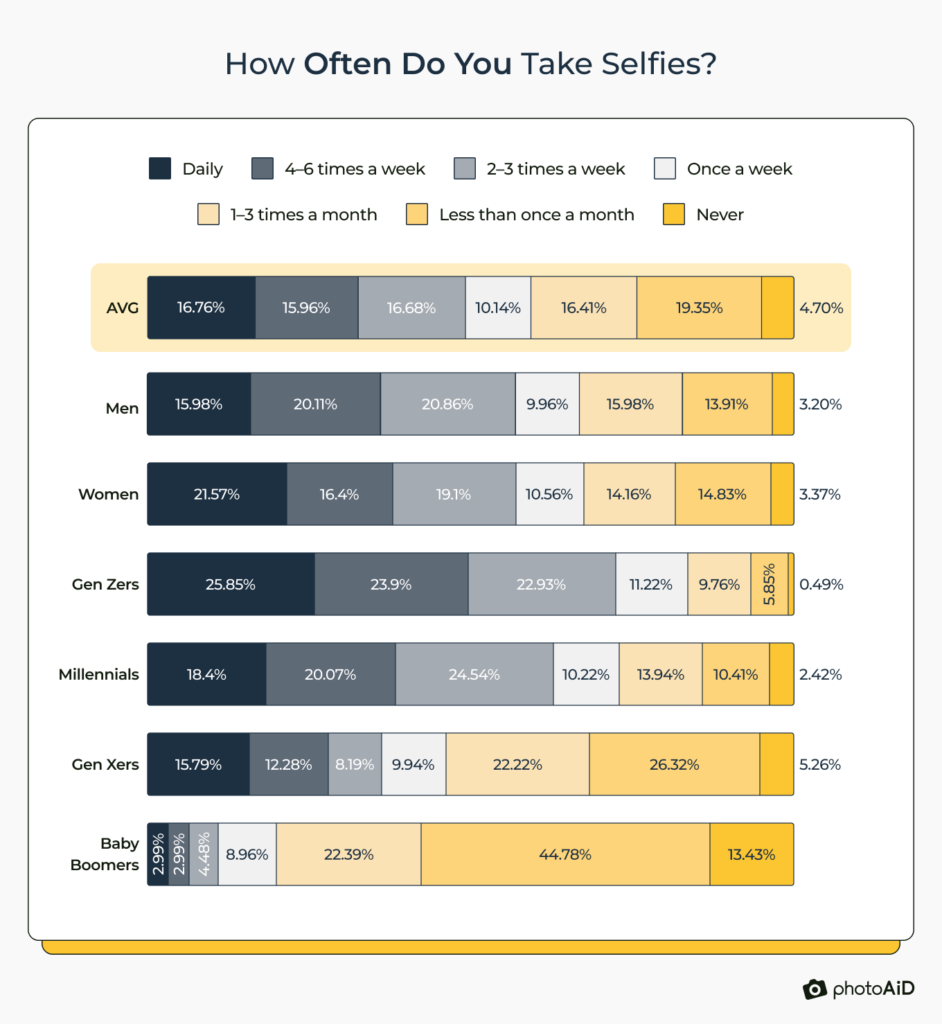
This habit is particularly noticeable among younger generations.
Gen Zers lead the pack, with 84% engaging in regular selfie-taking, followed by Millennials at 73%. Older generations, Gen Xers (46%) and Baby Boomers (19%), are less inclined toward this trend.
This generational gap could be attributed to the digital nativity and social media influence among youngsters.
Now—
We also found ourselves curious about the typical timing of selfie-taking.
Let’s dive into what our data revealed:
| At What Time of Day Do You Most Often Take Selfies? | In % |
|---|---|
| At various times throughout the day | 36.49 |
| Morning | 19.57 |
| Evening | 17.94 |
| Afternoon | 12.64 |
| Night | 5.2 |
| I’m not sure | 4.79 |
The most common time is “at various times throughout the day,” chosen by 36% of respondents. Mornings (20%) and evenings (18%) are also popular, likely due to favorable natural lighting.
As our penultimate question for this section, we inquired about the time typically needed to take a selfie.
Below are the results:
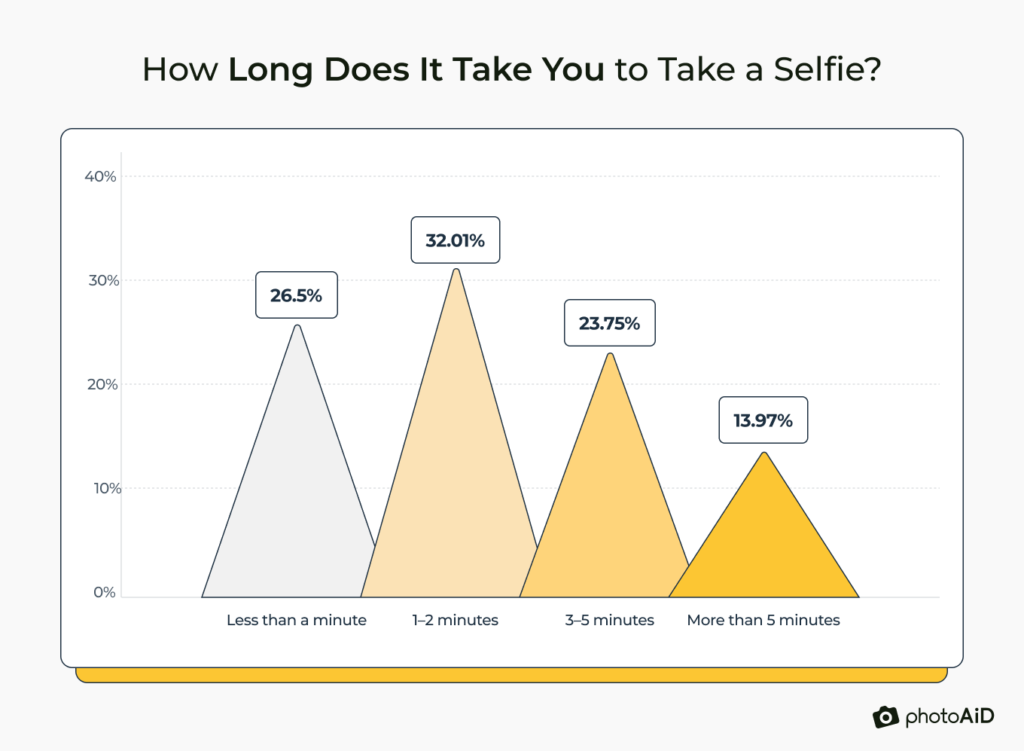
The majority (59%) of people usually snap their selfies in a brief span, not exceeding two minutes on average.
Finally, we wanted to explore the most common locations for taking self-portraits:
| Where Do You Usually Take Selfies? (In %) | AVG | Men | Women |
|---|---|---|---|
| Outdoors | 21.17 | 22.56 | 19.78 |
| At home | 18.89 | 15.98 | 21.8 |
| While traveling | 18.65 | 18.42 | 18.88 |
| Social events | 16.12 | 17.86 | 14.38 |
| Cafes or restaurants | 10.11 | 9.21 | 11.01 |
| Work or school | 4.34 | 5.08 | 3.6 |
| Gym | 3.27 | 4.51 | 2.02 |
| In the car | 2.52 | 1.88 | 3.15 |
Our data shows the top spot is outdoors (21%). Following closely are home (18.89%) and while traveling (18.65%).
Notably, men are more inclined to take selfies outdoors (23%) compared to women (20%). In contrast, women are more prone to take selfies at home: 22% vs. 16%.
Now—
In our next section, we’ll delve into how Americans edit their selfies and the extent of these edits.
Cropping, Rotating, and Flipping Are the Most Common Photo Edits
Photo editing has become ubiquitous.
Whether for a quick touch-up or a complete makeover, apps like Adobe Lightroom, Lensa, or VSCO have transformed how we present ourselves online.
So—
From our end, we were curious about which type of edits people most commonly apply to their self-portraits.
The results are in:
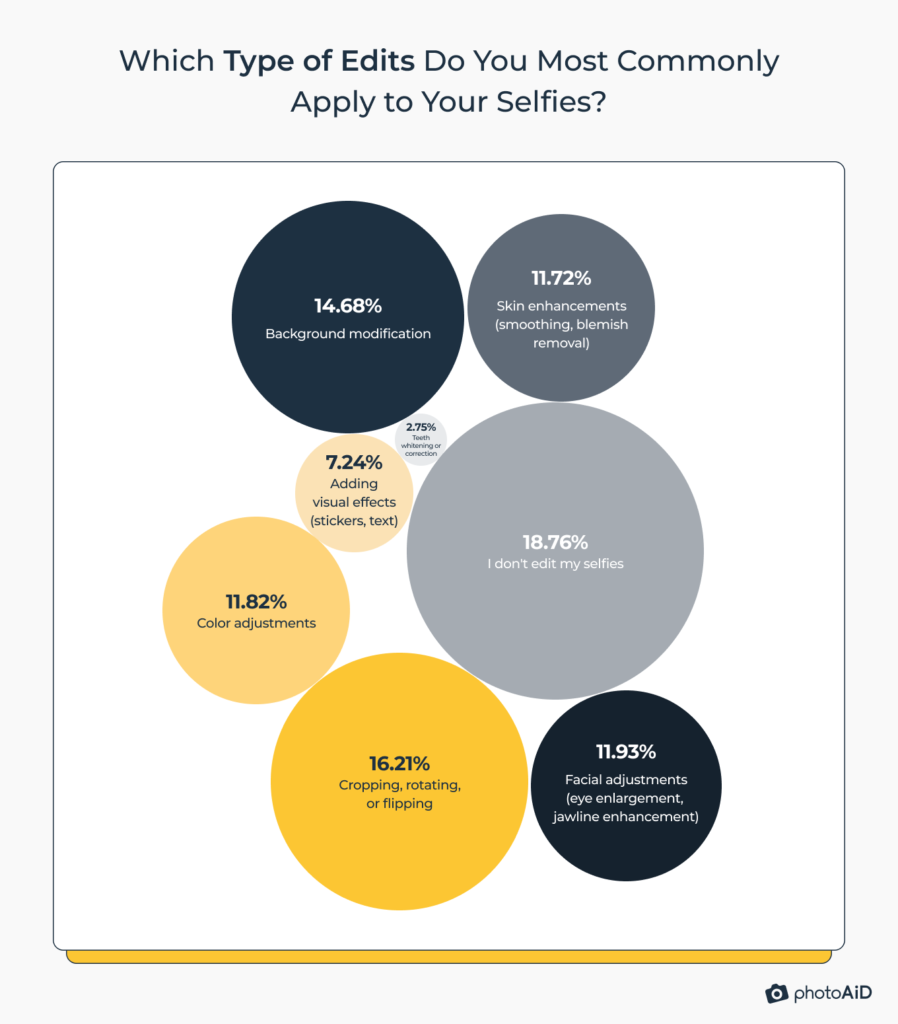
Interestingly, a significant portion of individuals (19%) said they prefer to keep their selfies unedited.
The most common editing action, however, is basic photo manipulation, like cropping, rotating, or flipping, chosen by 16%. This suggests a focus on improving the composition or orientation of the selfie without drastically altering its content.
With this, we also wanted to gauge to what extent respondents believe selfies shared on social media authentically represent the individual.
Let’s look at the data:
| To What Extent Do You Believe Selfies Shared on Social Media Are an Authentic Representation of the Individual? | In % |
|---|---|
| Mostly authentic | 31.7 |
| About half are authentic; half are not | 22.12 |
| Always authentic | 19.67 |
| Mostly inauthentic | 17.02 |
| Never authentic | 4.89 |
| Unsure / No opinion | 4.59 |
The takeaway?
Opinions on the authenticity of selfies shared on social media run the gamut.
Many believe these self-portraits are mostly (32%) or always (20%) authentic. On the other hand, a considerable proportion views them as inauthentic to varying degrees.
This diversity in perception might reflect the debates about reality versus presentation on social media platforms.
It also highlights differing awareness and attitudes toward photo editing and the curation of an online persona.
“Capturing Memories” Is the Most Common Reason for Taking Selfies
As mentioned earlier, capturing our own images has deep historical roots.
In fact, today’s selfie culture, propelled by smartphones and the internet, is simply the latest expression of this age-old human longing.
But—
What’s driving us to take self-portraits?
Our data has the answer:
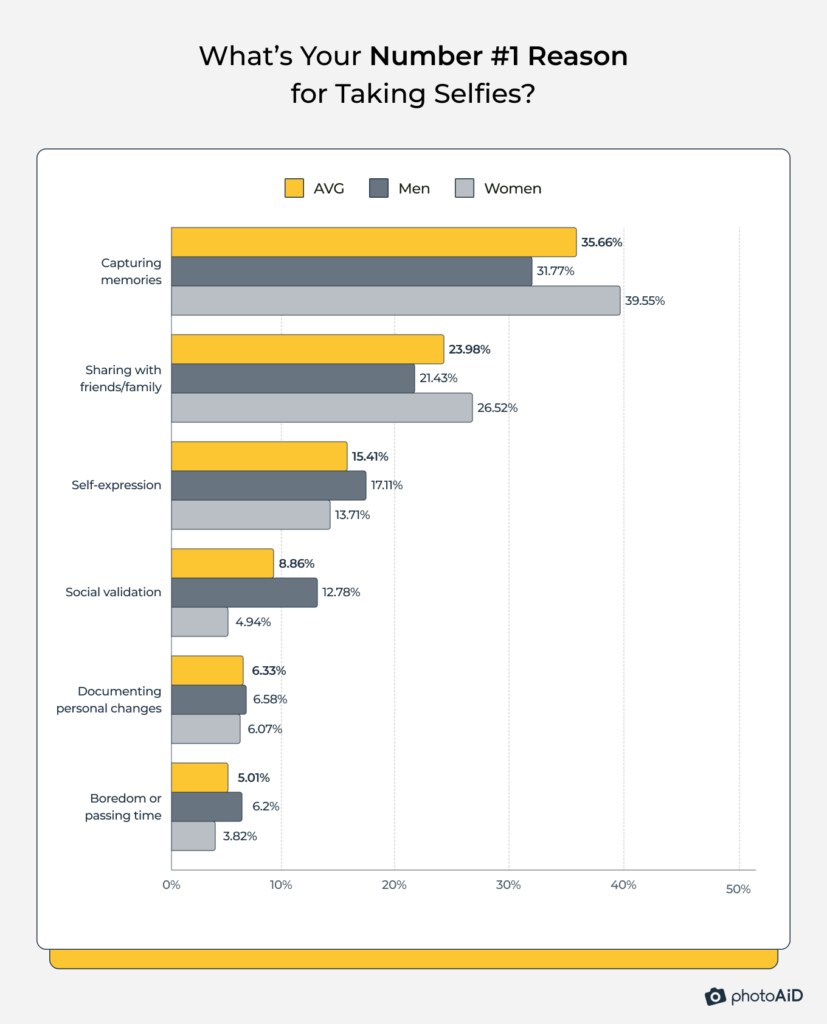
The most prevalent reason for taking selfies is “capturing memories” at 36%.
This motivation is more common among women (40%) than men (32%). In contrast, men are more inclined toward self-expression (17%) and seeking social validation (13%).
Interestingly, both genders similarly use selfies to document personal changes (6%), and a smaller group takes self-portraits out of boredom or to pass the time (5%).
Who knew boredom could be so photogenic?
The Majority View Positively the Societal Impact of People Posting Selfies Online
So far, so good.
Now—
Before we say our goodbyes, we wanted to examine how respondents perceive selfies socially.
After all, selfie culture has sparked a lot of discussion and controversy surrounding self-obsession, addiction to social media, and the pursuit of perfection in recent years.
The results are in:
| How Do You Perceive the Overall Impact of People Posting Selfies Online on Society? | AVG | Gen Zers | Millennials | Gen Xers | Baby Boomers |
|---|---|---|---|---|---|
| Very positive | 30.80% | 44.88% | 39.78% | 28.07% | 10.45% |
| Somewhat positive | 29.16% | 30.73% | 35.32% | 22.22% | 28.36% |
| Somewhat negative | 19.39% | 15.12% | 11.34% | 25.73% | 25.37% |
| Not sure / No opinion | 13.76% | 4.88% | 10.22% | 17.54% | 22.39% |
| Very negative | 6.90% | 4.39% | 3.35% | 6.43% | 13.43% |
As you can see, most respondents (60%) perceive the overall impact of people posting selfies online as somewhat positive (29%) or very positive (31%).
When we take a generational dive, nuances crop up.
Gen Zers (76%) and Millennials (75%) are the most likely to have a more positive view of selfie-sharing.
On the other hand, Gen Xers (50%) hold a more moderate perspective, while Baby Boomers (39%) are more likely to express reservations or even opposing views about the practice.
Could they be onto something?
We’ll leave that for you to decide.
Stacking It All Up
There you have it.
A comprehensive look at America’s selfie culture.
Now—
If you believe your audience will be interested in this information, feel free to share it. Just remember to mention the source and link back to this page.
Methodology
We conducted an online survey of 1,044 US respondents via a bespoke online polling tool in November 2023.
The respondents were 52.4% male, 45.4% female, and 0.4% identified as other. 20.9% of respondents were 26 or younger, 54.8% were aged 27–42, 17.4% were aged 43–58, and 6.8% were 59 or older.
This survey has a confidence level of 95% and a margin of error of 3%. Given the gender and age makeup of our sample size, the study’s findings are statistically significant for the population at large.
This study was created through multiple research steps, crowdsourcing, and surveying. Data scientists reviewed all survey participants’ responses for quality control. The survey also had an attention-check question.
Sources
- BBC, “The European City Where Selfies Are ‘Awkward’”
- MAIZE, “Selfie Culture”
- NLM, “How Do ‘Selfies’ Impact Adolescents’ Well-Being and Body Confidence? A Narrative Review”

As a Digital PR specialist and a member of the Society of Professional Journalists (SPJ), I have 5+ years of writing experience.
Over the course of my career, my work has garnered significant attention, with features in numerous prominent publications such as The New York Times, Forbes, Inc., Business Insider, Fast Company, Entrepreneur, BBC, TechRepublic, Glassdoor, and G2.
